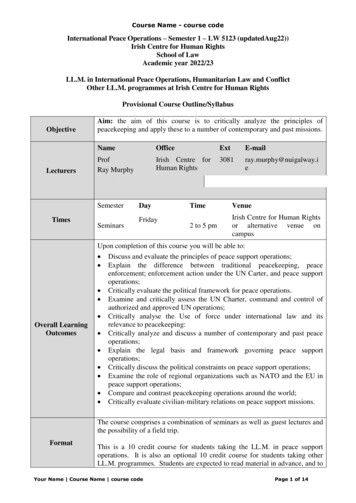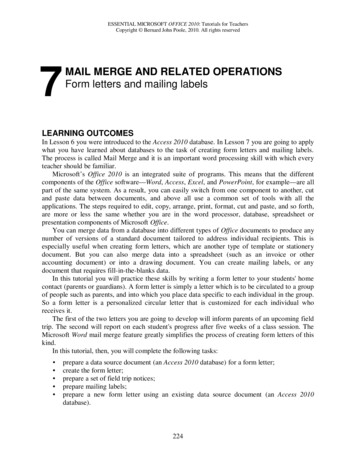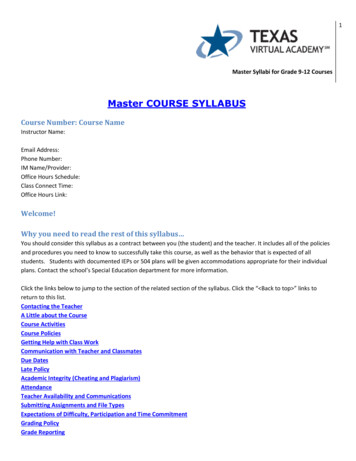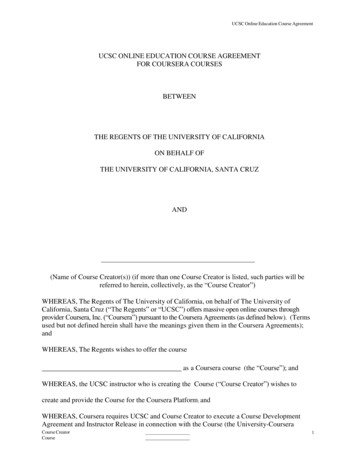
Transcription
Name of Course : E1-E2 CFAChapter 5Topic : MPLS VPNDate of Creation : 17.03.2011
E1-E2 (CFA)/MPLS VPNRev Date: 17-03-11Multi-Protocol Label Switching (MPLS VPN)What is MPLS?Multi Protocol Label Switching (MPLS) is a data-carrying mechanism in packet-switchednetworks. It operates at a layer that is generally considered to lie between traditional definitionsof Layer 2 (data link layer) and Layer 3 (network layer or IP Layer), and thus MPLS is oftenreferred to as a "Layer 2.5" protocol. It was designed to provide a unified data-carrying servicefor both circuit-based clients and packet-switching clients, which provide a data-gram servicemodel. It can be used to carry many different kinds of traffic, including IP packets, as well asnative ATM, SONET, Frame relay and Ethernet frames. The IP network has emerged as thenetwork for providing converged, differentiated classed of services to user with optimal use ofresources and also to address the issues related to Class of service (CoS) and Quality of Service(QoS). MPLS is the technology that addresses all the issues in the most efficient manner. MPLSis a packet-forwarding technology that uses labels to make data forwarding decisions.What is a MPLS header?MPLS works by prefixing packets with an MPLS header, containing one or more 'labels'.This is called a label stack. Each label stack entry contains four fields: 20-bit label value (This is MPLS Label) 3-bit Experimental field used normally for providing for QoS (Quality of Service) 1-bit bottom of stack flag. If this is 1, signifies that the current label is the last in thestack. 8-bit TTL (time to live) field.Various Routing function units & Routers in MPLSRouting function in MPLS can be described on the basis of some units, which are defined asfollows:Label: A label is an identifier, which indicates the path a packet, should traverse. Label iscarried along with the packet. The receiving router examines the packet for its label content todetermine the next hop. Once a packet has been labeled, the rest of the journey of the packetthrough the backbone is based on label switching. Since every intermediate router has to look into the label for routing the decision making at the level of router becomes fast.BSNL, IndiaFor Internal Circulation OnlyPage 1
E1-E2 (CFA)/MPLS VPNRev Date: 17-03-11Label Creation: Every entry in routing table (build by using any IGP protocol) is assigned aunique 20-bit label.Swap: Every incoming label is replaced by a new outgoing label (As per the path to be followed)and the packet is forwarded along the path associated with the new label.Push: A new label is pushed on top of the packet, effectively "encapsulating" the original IPpacket in a layer of MPLS.POP: The label is removed from the packet effectively "de-encapsulating". If the popped labelwas the last on the label stack, the packet "leaves" the MPLS tunnel.LER: A router that operates at the edge of the access network and MPLS network LERperforms the PUSH and POP functions and is also the interface between access and MPLSnetwork, commonly know as Edge router.LSR: An LSR is a high-speed router device in the core of an MPLS network, normally calledCore routers. These routers perform swapping functions and participate in the establishment ofLabel Switch Path (LSP)Ingress / Egress Routers: The routers receiving the incoming traffic or performing the firstPUSH function are ingress routers and routers receiving the terminating traffic or performing thePOP function are Egress routers. The same router performs both functionality i.e. Ingress andEgress. The routers performing these functions are LER.FEC: The forward equivalence class (FEC) is a representation of a group of packets that sharethe same requirements for their transport. All packets in such a group are provided the sametreatment en route to the destination. As opposed to conventional IP forwarding, in MPLS, theassignment of a particular packet to a particular FEC is done just once, as the packet enters thenetwork at the edge router.MPLS functions:MPLS performs following functions: Specifies mechanisms to manage traffic flow of various granularities, such as flowsbetween different hardware, machines, or even flows between different applications. MPLS remains independent of the Layer-2 & layer-3 protocols. Meaning thereby thatlabel encapsulating the data packet does not depend upon layer 3 /layer 2 protocol ofdata. This justifies the name as multi protocol label switching.BSNL, IndiaFor Internal Circulation OnlyPage 2
E1-E2 (CFA)/MPLS VPNRev Date: 17-03-11 Provides a means to map IP addresses to simple, fixed-length labels used by differentpacket-forwarding and packet-switching technologies Interfaces to existing routing protocols such as resource reservation protocol (RSVP) andopen shortest path first (OSPF). Supports the IP, ATM, and frame- relay Layer-2 protocols.Label Distribution Protocol (LDP):The LDP is a protocol for the distribution of label information to LSRs in a MPLS networks. It isused to map FECs to labels, which, in turn, create LSP. LDP sessions are established betweenLDP peers in the MPLS network (not necessarily adjacent).MPLS Operation:The following steps must be taken for a data packet to travel through an MPLS domain: Label creation and distribution Table creation at each router Label-switched path creation Label insertion/table lookup Packet forwarding.The source sends its data to the destination. In an MPLS domain, not all of the source traffic isnecessarily transported through the same path. Depending on the traffic characteristics, FEC sdifferent LSP s could be created for packets with different CoS requirements.In Figure 1, LER1 is the ingress and LER4 is the egress router.LSP Creation & and Packet forwarding through an MPLS DomainBSNL, IndiaFor Internal Circulation OnlyPage 3
E1-E2 (CFA)/MPLS VPNRev Date: 17-03-11134.5.6.1134.5.1.5Egress Routing Table200.3.2.723Ingress Routing TableDestinationNext Hop134.5/16(2, 84)200.3.2/24(3, 99)200.3.2.7 9912200.3.2.7 03DestinationNext 00.3.2.7 56MPLS TableIn(1, 99)MPLS TableOut(2, 56)In(3, 56)Out(5, 0)200.3.2.1200.3.2.7Figure-1Tunneling in MPLSA unique feature of MPLS is that it can control the entire path of a packet without explicitlyspecifying the intermediate routers. It does this by creating tunnels through the intermediaryrouters that can span multiple segments. This concept is used for provisioning MPLS – basedVPNs. (Figure-2)Figure-2BSNL, IndiaFor Internal Circulation OnlyPage 4
E1-E2 (CFA)/MPLS VPNRev Date: 17-03-11MPLS ApplicationsMPLS addresses today’s network backbone requirements effectively by providing a standardsbased solution that accomplishes the following: Improves packet-forwarding performance in the network. MPLS enhances and simplifies packet forwarding through routers using Layer-2switching paradigms. MPLS is simple which allows for easy implementation. MPLS increases network performance because it enables routing by switching at wireline speeds. Supports QoS and CoS for service differentiation. MPLS uses traffic-engineered path setup and helps achieve service-level guarantees. MPLS incorporates provisions for constraint-based and explicit path setup.Supports network scalability.MPLS can reuse existing router/ATM switch hardware, effectively joining the twodisparate networks.Builds interoperable networksMPLS is a standards-based solution.MPLS helps build scalable VPNs with traffic-engineering capability.MPLS VPNMPLS technology is being widely adopted by service providers worldwide to implementVPNs to connect geographically separated customer sites. VPNs were originally introduced toenable service providers to use common physical infrastructure to implement emulated point-topoint links between customer sites. A customer network implemented with any VPN technologywould contain distinct regions under the customer's control called the customer sites connectedto each other via the service provider (SP) network. In traditional router-based networks,different sites belonging to the same customer were connected to each other using dedicatedpoint-to-point links. The cost of implementation depended on the number of customer sites to beconnected with these dedicated links. A full mesh of connected sites would consequently implyan exponential increase in the cost associated. Frame Relay and ATM were the first technologieswidely adopted to implement VPNs.These networks consisted of various devices, belonging to either the customer or the serviceprovider, that were components of the VPN solution. Generically, the VPN realm would consistof the following regions:BSNL, IndiaFor Internal Circulation OnlyPage 5
E1-E2 (CFA)/MPLS VPNRev Date: 17-03-11Customer network— Consisted of the routers at the various customer sites. The routersconnecting individual customers' sites to the service provider network were called customer edge(CE) routers.Provider network— Used by the service provider to offer dedicated point-to-point links overinfrastructure owned by the service provider. Service provider devices to which the CE routerswere directly attached were called provider edge (PE) routers. In addition, the service providernetwork might consist of devices used for forwarding data in the backbone called provider (P)routers.Classification of VPN ImplementationsDepending on the service provider's participation in customer routing, the VPN implementationscan be classified broadly into one of the following: Overlay model Peer-to-peer modelOverlay model Service provider doesn’t participate in customers routing, only provides transport tocustomer data using virtual point-to-point links. As a result, the service providerwould only provide customers with virtual circuit connectivity at Layer 2. If the virtual circuit was permanent or available for use by the customer at all times, itwas called a permanent virtual circuit (PVC). If the circuit was established by the provider on-demand, it was called a switchedvirtual circuit (SVC).The primary drawback of an Overlay model was the full mesh of virtual circuitsbetween all customer sites for optimal connectivity. It resembles the physical meshconnectivity in case of leased lines. Overlay VPNs were initially implemented by theSP by providing either Layer 1 (physical layer) connectivity or a Layer 2 transportcircuit between customer sites.In the Layer 1 implementation, the SP would provide physical layer connectivity betweencustomer sites, and the customer was responsible for all other layers. In the Layer 2implementation, the SP was responsible for transportation of Layer 2 frames (or cells) betweencustomer sites, which was traditionally implemented using either Frame Relay or ATM switchesas PE devices. Therefore, the service provider was not aware of customer routing or routes.Later, overlay VPNs were also implemented using VPN services over IP (Layer 3) withtunneling protocols like L2TP, GRE, and IPSec to interconnect customer sites. In all cases, the BSNL, IndiaFor Internal Circulation OnlyPage 6
E1-E2 (CFA)/MPLS VPNRev Date: 17-03-11SP network was transparent to the customer, and the routing protocols were run directly betweencustomer routers.Peer-to-peer modelThe peer-to-peer model was developed to overcome the drawbacks of the Overlay model andprovide customers with optimal data transport via the SP backbone. Hence, the service providerwould actively participate in customer routing. In the peer-to-peer model, routing information isexchanged between the customer routers and the service provider routers, and customer data istransported across the service provider's core, optimally. Customer routing information is carriedbetween routers in the provider network (P and PE routers) and customer network (CE routers).The peer-to-peer model, consequently, does not require the creation of virtual circuits. The CErouters exchange routes with the connected PE routers in the SP domain. Customer routinginformation is propagated across the SP backbone between PE and P routers and identifies theoptimal path from one customer site to another.Dial VPN ServiceMobile users of a corporate customer need to access their Corporate Network from remotesites. Dial VPN service enables to provide secure remote access to the mobile users of theCorporate. Dial VPN service, eliminates the burden of owning and maintaining remote accessservers, modems, and phone lines at the Corporate Customer side. Currently accessible fromPSTN (127233) & ISDN (27225) also from Broadband.MPLS VPN Architecture and TerminologyIn the MPLS VPN architecture, the edge routers carry customer routing information, providingoptimal routing for traffic belonging to the customer for inter-site traffic. The MPLS-based VPNmodel also accommodates customers using overlapping address spaces, unlike the traditionalpeer-to-peer model in which optimal routing of customer traffic required the provider to assignIP addresses to each of its customers (or the customer to implement NAT) to avoid overlappingaddress spaces. MPLS VPN is an implementation of the peer-to-peer model; the MPLS VPNbackbone and customer sites exchange Layer 3 customer routing information, and data isforwarded between customer sites using the MPLS-enabled SP IP backbone.The MPLS VPN domain, like the traditional VPN, consists of the customer network and theprovider network. The MPLS VPN model is very similar to the dedicated PE router model in apeer-to-peer VPN implementation. However, instead of deploying a dedicated PE router percustomer, customer traffic is isolated on the same PE router that provides connectivity into theservice provider's network for multiple customers. The components of an MPLS VPN shown inFigure are highlighted next.BSNL, IndiaFor Internal Circulation OnlyPage 7
E1-E2 (CFA)/MPLS VPNRev Date: 17-03-11Figure-3: MPLS VPN Network ArchitectureFigure-3The main components of MPLS VPN architecture are:Customer network, which is usually a customer-controlled domain consisting of devices orrouters spanning multiple sites belonging to the customer. In Figure, the customer network forCustomer A consists of the routers CE1-A and CE2-A along with devices in the Customer-Asites 1 and 2.CE routers, which are routers in the customer network that interface with the service providernetwork. In Figure, the CE routers for Customer A are CE1-A and CE2-A, and the CE routers forCustomer B are CE1-B and CE2-B. Provider network, which is the provider controlled domainconsisting of provider edge and provider core routers that connect sites belonging to thecustomer on a shared infrastructure. The provider network controls the traffic routing betweensites belonging to a customer along with customer traffic isolation.In Figure, the provider network consists of the routers PE1, PE2, P1, P2, P3, and P4.PE routers, which are routers in the provider network that interface or connect to the customeredge routers in the customer network. PE1 and PE2 are the provider edge routers in the MPLSVPN domain for customers A and B. P routers, which are routers in the core of the providernetwork that interface with either other provider core routers or provider edge routers. RoutersP1, P2, P3, and P4 are the provider routers.BSNL, IndiaFor Internal Circulation OnlyPage 8
E1-E2 (CFA)/MPLS VPNRev Date: 17-03-11Advantages of MPLS over other technologiesBSNL's primary objectives in setting up the BGP/MPLS VPN network are: Provide a diversified range of services (Layer 2, Layer 3 and Dial up VPNs) to meet therequirements of the entire spectrum of customers from Small and Medium to Largebusiness enterprises and financial institutions. Make the service very simple for customers to use even if they lack experience in IProuting. Make the service very scalable and flexible to facilitate large-scale deployment. Provide a reliable and amenable service. Offering SLA to customers. Capable of meeting a wide range of customer requirements, including security, quality ofService (QOS) and any-to-any connectivity. Capable of offering fully managed services to customers.BSNL, IndiaFor Internal Circulation OnlyPage 9
E1-E2 (CFA)/MPLS VPNRev Date: 17-03-11Allow BSNL to introduce additional services such as bandwidth on demand etcover the same network.MPLS TariffTARIFF OF MPLS BASED IP-VPN SERVICEhttp://bsnl.co.in/service/mplsvpn tariff.htmTariff of MPLS VPN and IP VPN Services in Rs.:Particular 64 Kbps 128 Kbps 192 Kbps 256 Kbps 384 Kbps 512 200088000116000149000185000249000BronzeIP 0137000219000186000Particular768Kbps1 Mbps2 Mbps8 Mbps34 Mbps45 7000305000355000124200022720002556000IP VPN229000263000294000102800018800002115000Tariff for higher bandwidth i.e. 100Mbps, STM1, 1 Gbps and 2.5GbpsParticularGoldSilverBronzeBest Effort100mbps8079500645950047050003893500STM1 (155Mbps)117700009410000685400056720001 00809260005894440048779200 Committed Data Rate in Bronze category - The bandwidth of Bronze category would berestricted to 50% of bandwidth. However, the minimum B/W of 25% B/W will be committedto Bronze customers. Discount on MPLS VPN ports - It has been decided to give multiple port discounts on thetotal number of ports hired across the country as given below. It may be noted that multipleports are not required to be located in a city for offering this discount:BSNL, IndiaFor Internal Circulation OnlyPage 10
E1-E2 (CFA)/MPLS VPNNo. of Ports1 to 4 ports5 to 25 ports26 to 50 ports51 to 100 ports101 to 150 portsMore than 150 portsRev Date: 17-03-11Existed discount onVPN Ports on Gradedbasis0%10%15%20%20%20%Revised discount onVPN Ports on Nongraded basis0%5%10%10%15%20%Volume based discount on MPLS VPN Service - Annual volume based discount on graded basismay be given to all customers as under:Annual Revenue (in Rs.) on MPLSVPN Service per annumVolume based Discount on GradedbasisNo discount5%7.5%10%15%Up to Rs.50 lakhsRs.50 lakhs to 1 CroreRs.1 Crore to 2 CroreRs.2 Crore to 5 CroreMore than Rs.5 Crore Shifting charges of MPLS VPN & IP VPN Port - Rs.2000/- per port. Minimum hiring period for MPLS VPN and IP VPN ports - One year. Up-gradation of port to higher Bandwidth – No charges to be levied for up-gradation tohigher bandwidth. The rent for the lower BW port to be adjusted on pro-rata basis. Provision of last mile on R&G/ Special construction basis - The charges to be levied asper prevalent R&G/ Special construction terms. Local Lead charges: Included in Port Charges, if these are within Local Area ofTelephone system of a City/Town (Virtual Nodes). All charges are exclusive of Service Tax.Tariff for Postpaid dial-up VPN Service from MPLS VPN customers (w.e.f 1st May, 2007):I.Duration Based Plans:Number of Dial-in UsersBSNL, IndiaFor Internal Circulation OnlyPage 11
E1-E2 (CFA)/MPLS VPNRev Date: 17-03-11Particulars5 Users25 Users50 Users100 Users250 usersSecurity Deposit (Rs.)Activation charges (one time) Rs.Monthly fixed charges (Rs.)Monthly free usages (equivalent toRs.)Credit Limit (Rs.)Usage Charges (Rs. per hour)PSTNISDN (64K)Other Charges per User per month (Rs.)CLI Restriction DeactivationTime of Day access RestrictionDetails of child usagesSource NAP restriction 01055101055101055101055II.Volume Based Plans:5 UsersNumber of Dial-in Users25 Users50 Users 100 Users250 usersParticularsSecurity Deposit (Rs.)Activation charges (one time) Rs.Monthly fixed charges (Rs.)Monthly free usages (equivalent toRs.)Credit Limit (Rs.)Usage Charges (Rs. per MB)PSTNISDN (64K)Other Charges per User per month (Rs.)CLI Restriction DeactivationTime of Day access RestrictionDetails of child usagesSource NAP restriction 00.550.600.50101055101055101055101055101055Other terms and conditions: Monthly Fixed charges are payable in advance; Minimum 10 MPLS leased line ports should be in VPN before Postpaid dial-up facility isallowed; Account will be deactivated once credit limit is crossed and fresh Action Charge will bepayable;BSNL, IndiaFor Internal Circulation OnlyPage 12
E1-E2 (CFA)/MPLS VPNRev Date: 17-03-11 PSTN/ ISDN rentals and access charges will be extra; Service Tax will be extra.FAQ’s Regarding BSNL MPLS VPN can be seen athttp://bsnl.co.in/faq/mplsvpn faq.htmMore Reading: - http://www.iec.org/online/tutorials/Questions1) Write MPLS header format2) Write the two models of VPN3) Write the advantages of MPLS VPN4) Write the advantages of MPLS5) Write some applications of MPLSxxxxBSNL, IndiaFor Internal Circulation OnlyPage 13
E1-E2 (CFA)/MPLS VPN Rev Date: 17-03-11 BSNL, India For Internal Circulation Only Page 7 SP network was transparent to the customer, and the routing protocols were run directly between customer routers. Peer-to-peer model The peer-to-peer model was developed to overcome the drawbacks of the Overlay model and provide customers with optimal data .











